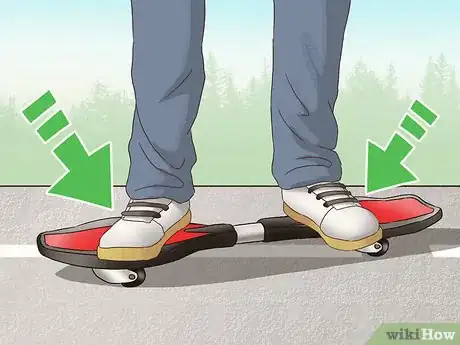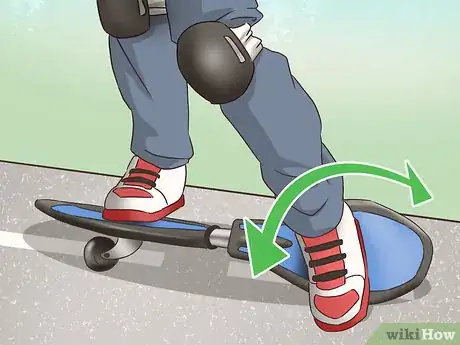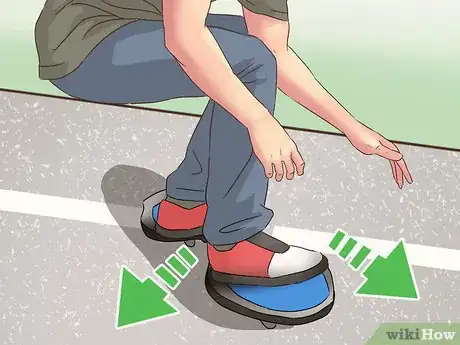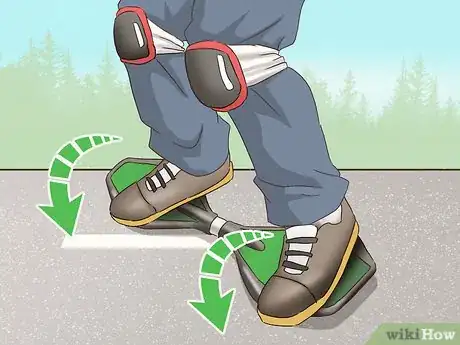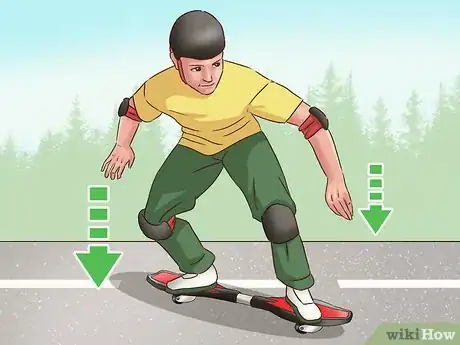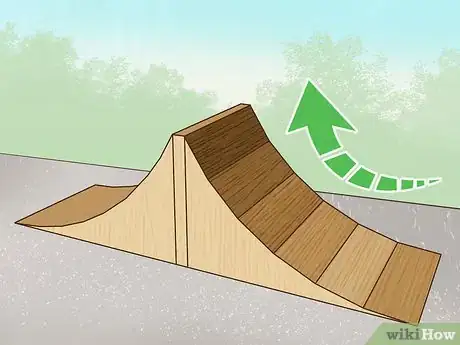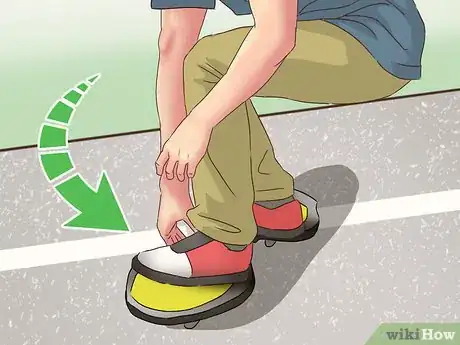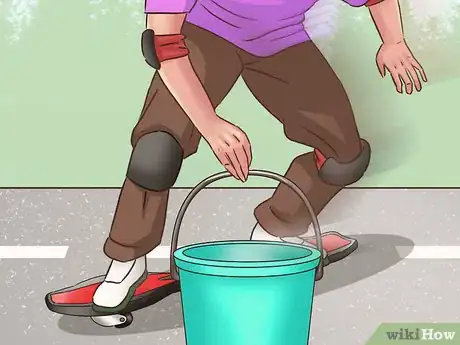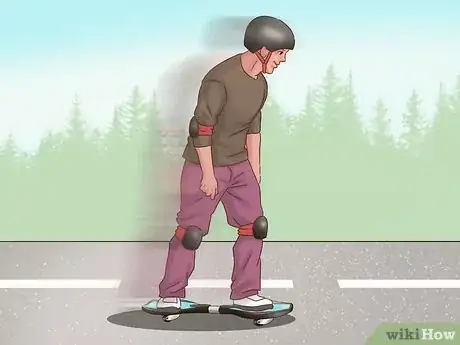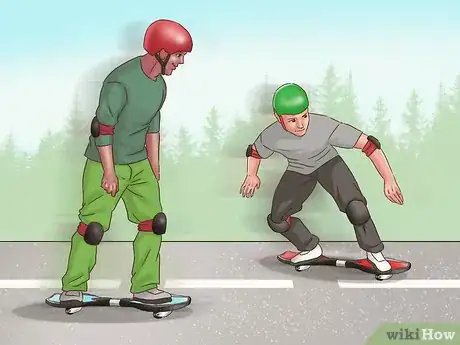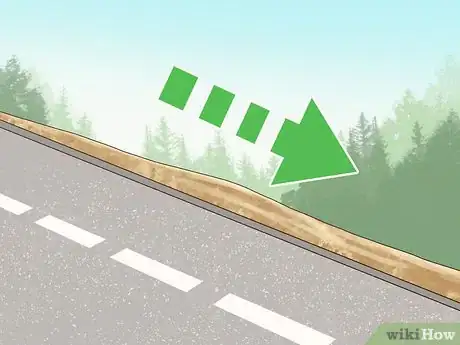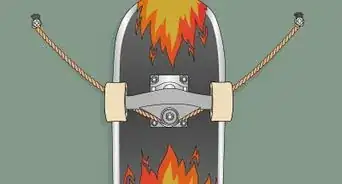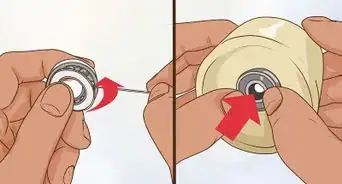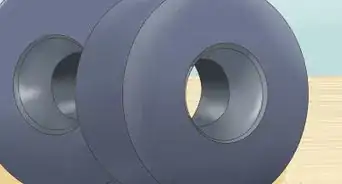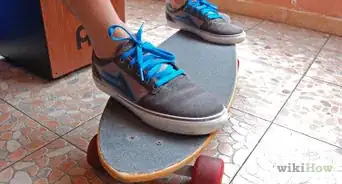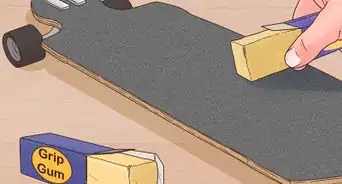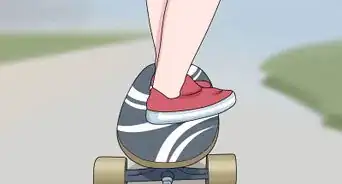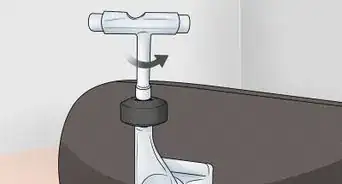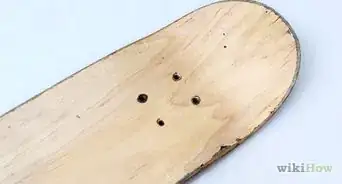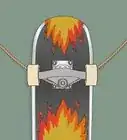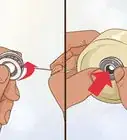This article was co-authored by wikiHow Staff. Our trained team of editors and researchers validate articles for accuracy and comprehensiveness. wikiHow's Content Management Team carefully monitors the work from our editorial staff to ensure that each article is backed by trusted research and meets our high quality standards.
This article has been viewed 62,258 times.
Learn more...
Waveboards are small but intuitive alternatives to traditional skateboards that can be much easier to master. A waveboard only has 2 wheels instead of 4 and a board that can bend mid-riding. The flexibility of a waveboard appeals to those who want to relax and ride down a flat street or those who want to engage in high-stakes obstacle courses.
Steps
Learning to Ride the Waveboard
-
1Gear up with a helmet and protective padding. You should always wear a helmet and protective padding when you ride on a waveboard, doubly so as a beginner.[1] Tighten your helmet so that it's snug on your head and make sure none of your padding is loose.
-
2Tilt the waveboard forward to get on it. Tilt the waveboard forward so that one edge of both panels are touching the ground. Step backwards onto both panels then push your heels back so that both panels flatten and you're now suspended above the ground and on the waveboard.[2]Advertisement
-
3Determine if you feel more comfortable with your right or left foot forward. Before setting off, get onto your waveboard. Put your left foot at the front first (known as regular style) then your right foot (known as goofy style). Consciously think about which foot feels stronger at the front.
- Once you choose a style, whichever foot you have placed at the front is known as your 'dominant foot'. Whichever foot you have placed at the back of the board is known as your 'non-dominant foot'.
- The only way to know which method is best for you is to try it out for yourself. Everyone's dominant foot can vary, so choose whichever method makes you more comfortable.
-
4Move by pushing with your non-dominant foot. Once you have chosen your dominant foot, plant it at the front of the waveboard and make sure you're steady. Then, gently push yourself forward with your non-dominant foot by pushing against the ground. Once you do, bring your non-dominant foot onto the tail of the board.[3]
- Don't start wiggling yet, just enjoy the brief motion and get a feel for the board beneath your feet.
-
5Wiggle gently with your non-dominant foot to gain speed. Once you feel confident in your balance you'll need to wiggle your non-dominant foot to gain speed. Slowly, move your non-dominant foot side to side as you move forwards as if you were a snowboarder.[4]
- Once you are able to wiggle your non-dominant foot confidently, try to move your hips with your non-dominant foot so that your lower body is now wiggling left and right too.
- This will propel the board forward, speeding you up.
-
6Practice turning by pushing your feet in contrary motions. Now that you know how to gather a little speed when you're moving on the waveboard, gently tilt your dominant foot to the right and your non-dominant foot to the left. This will make you turn right. If you tilt your dominant foot to the left and your non-dominant foot to the right, you will turn left.[5]
- Practice wiggling to gain speed, then doing slow turns, followed by more wiggling until you can do a basic circuit.
-
7Stop the waveboard by leaning forward. Stop wiggling to reduce your speed then lean forward on the waveboard and tilt your feet forwards. This will bring the waveboard to a stop.
- Alternatively, if you feel confident, you can just jump off the waveboard and it will come to a stop on its own.[6]
Trying Basic Tricks
-
1Duck down while you ride for your first trick. As you ride along, slowly bend your knees until you're on your haunches but still moving forward. Then, once you've held the position for a few moments, rise to your feet again.
-
2Skate on ramps or bowls for airtime. After you are confident on a waveboard, the next step may be to learn some tricks and practice gaining airtime. Most cities will have a skate-park with bowls, large domes in the ground that you can use to propel yourself upwards.
- Try gaining some speed and going over ramps first of all to get a feel for how the waveboard functions in the air. Once you're more confident in the air, you can try and board up the side of a bowl and into the air.
- When in the air, grab the top of your board with your closest hand and bring your knees into your chest. Once you hit this position, revert back to your normal position and attempt to land the trick. This is called a grab.
-
3Grab the center bar of the waveboard for a technical trick. As you are moving forward, slowly bend your knees and grab the center bar attaching the nose and tail of the waveboard and continue moving. Once you've held the position for a few moments, gently rise to your feet again.
-
4Test your dexterity by picking up buckets as you ride. Before getting on your waveboard, set up several buckets along a track. Then, get on your waveboard and in a smooth motion try to ride past the buckets and pick them up, gathering them as you go.
- For increased difficulty, try and fill the buckets up with water. The amount of water you spill from the bucket indicates the degree of control you have on the waveboard.
Riding your Waveboard in Different Ways
-
1Cruise the streets as a relaxing pastime. If you just want to relax on your board, head out onto your local streets and cruise up and down them, exploring new areas. There's no pressure on you to go fast, so this method is ideal if you're just starting out.
-
2Learn to race on waveboards with friends. Grab a couple of friends who also have waveboards and with a set of cones construct a circuit to race around. This is a blast and forms good practice for turning and building speed.[7]
- With a set of cones, set up a typical figure of 8 race course. Hold a few practice laps first to get a feel for the cornering before racing a friend. Get someone to tell you when to go, then race around the circuit for a set amount of laps until someone wins the race.
- Experiment with the corners and route of your circuit so that you're always challenging yourself to develop a different skill.
- If your group of friends only has 2 waveboards, you can set up a relay race where the original rider hops off and a new racer hops on halfway through the race, or after a full lap.
-
3Carve down some hills for an adrenaline rush. Waveboarders board down large hills to build up major speed. Start on a shallow descending hill and ride down it, swaying from left to right as a skier would down a mountainside.[8]
- Once you gain some confidence carving down smaller hills, try some bigger ones. Protective gear is crucial if you're boarding at speed.
Community Q&A
-
QuestionAre the wheels supposed to move around?
 Community AnswerYes.
Community AnswerYes. -
QuestionIf I am right-handed, should I use goofy or regular?
 Community AnswerIt is your choice. It doesn't matter if you are a left or right-handed person, choose what works best for you.
Community AnswerIt is your choice. It doesn't matter if you are a left or right-handed person, choose what works best for you. -
QuestionWhat is the capacity of weight on a wave board ?
 Community AnswerThere are various wave boards for various weights. Most are 50kg to 100kg but there could be bigger ones.
Community AnswerThere are various wave boards for various weights. Most are 50kg to 100kg but there could be bigger ones.
Warnings
- Always wear a helmet even if you seem to be an expert at riding the waveboard.⧼thumbs_response⧽
- Make sure the area in which you live allows waveboards.⧼thumbs_response⧽
References
- ↑ https://youtu.be/c8TpIIPKXv0?t=16
- ↑ http://www.instructables.com/id/Waveboard-Riding-And-Tricks/
- ↑ https://healthfully.com/ride-fast-ripstik-8188474.html
- ↑ https://healthfully.com/ride-fast-ripstik-8188474.html
- ↑ https://youtu.be/c8TpIIPKXv0?t=197
- ↑ https://youtu.be/c8TpIIPKXv0?t=240
- ↑ http://www.streetdirectory.com/travel_guide/42286/extreme_sports/ways_to_ride_the_wave_board.html
- ↑ http://www.streetdirectory.com/travel_guide/42286/extreme_sports/ways_to_ride_the_wave_board.html
About This Article
To learn how to ride a waveboard, first put on a helmet and some protective padding in case you fall. Find a flat, paved surface you can practice on away from cars and pedestrians, like an empty parking lot or driveway. Place your waveboard on the ground and tilt it forward so one of the edges on each panel is touching the ground. If you’re regular-footed, you’ll ride with your right foot on the back of the waveboard. If you’re goofy-footed, you’ll ride with your left foot on the back. If you’re not sure, do whatever feels most comfortable. Place your back foot on the back panel of your waveboard, and use your foot to lift the waveboard up so it’s flat. Then, push off of the ground with your other foot and place that foot on the front panel of your waveboard. Try holding onto a wall while you practice mounting your waveboard until you get the hang of it. After you push off, wiggle your back foot side to side to gain speed and propel yourself forward. To turn, tilt your front foot in the direction you want to go in while tilting your back foot in the opposite direction. The more you tilt your front and back feet, the sharper the turn will be. To stop, stop wiggling your back foot and tilt both of your feet in the same direction. Once you’ve got the basics down, you can practice doing different tricks on your waveboard.


